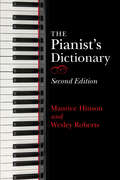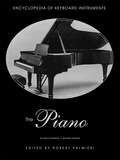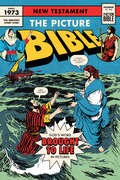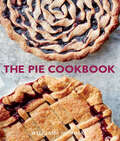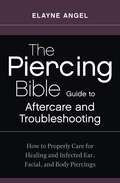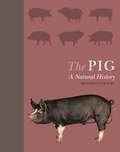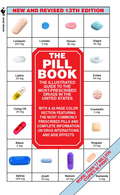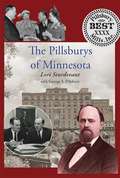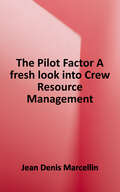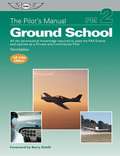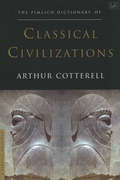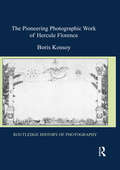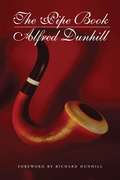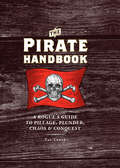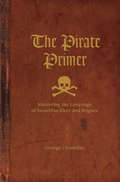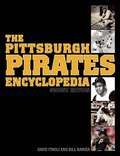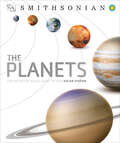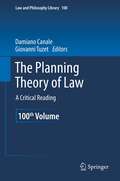- Table View
- List View
The Pianist's Dictionary
by Maurice Hinson Wesley RobertsFrom A to Z to middle C: An &“essential reference&” for piano students, teachers, players, and music lovers, with hundreds of definitions (E.L. Lancaster, Alfred Music).The Pianist&’s Dictionary is a handy and practical reference dictionary aimed specifically at pianists, teachers, students, and concertgoers. Prepared by Maurice Hinson and Wesley Roberts, this revised and expanded edition is a compendium of information gleaned from a combined century of piano teaching. Users will find helpful and clear definitions of musical and pianistic terms, performance directions, composers, pianists, famous piano pieces, and piano makers. The authors&’ succinct entries make The Pianist&’s Dictionary the perfect reference for compiling program and liner notes, studying scores, and learning and teaching the instrument. &“This new edition is a go-to source for piano scholars and students for quick information on musical terms, pianists, major works in the piano repertoire, piano manufacturers, and more . . . comprehensive, easy to use.&” —Jane Magrath, University of Oklahoma
The Piano in Chamber Ensemble, Third Edition: An Annotated Guide
by Maurice Hinson Wesley RobertsIn this expanded and updated edition, The Piano in Chamber Ensemble: An Annotated Guide features over 3200 compositions, from duos to octets, by more than 1600 composers. Maurice Hinson and Wesley Roberts catalog published works for piano with two or more instruments with information on performance level, length, individual movements, overall style, and publisher. Divided into sections according to the number and types of instruments involved, The Piano in Chamber Ensemble then subdivides entries according to the actual scoring. Keyboard, string, woodwind, brass, and percussion players and teachers will find a wealth of chamber works from all periods in this invaluable guide.
The Piano: An Encyclopedia
by Robert Palmieri Margaret W. PalmieriFirst Published in 2011. Routledge is an imprint of Taylor & Francis, an informa company.
The Picture Bible New Testament (Picture Bible)
by Iva HothFor nearly 50 years and with more than 3 million copies in print, The Picture Bible has transformed lives around the world through its fast-paced, easy-to-read narrative and comic-style illustrations.Now with beautifully refreshed packaging, this New Testament edition offers:74 stories in full-color comic formatmaps, a Scripture index, a biblical timeline, and “Did You Know?” fact pagesan engaging style that appeals to adults who are new to the Bible as well as to kids and teens Continuing the remarkable legacy of The Picture Bible, this stand-alone New Testament serves as an ideal evangelism tool for churches and outreaches, a great book for family Bible time, and a trustworthy first Bible for anyone who needs to know the powerful love of Jesus.
The Picture-Perfect Golf Swing: The Complete Guide to Golf Swing Video Analysis
by Michael BreedVideo swing analysis revolutionized the way golf is taught, but players have had to rely on teaching professionals to analyze their swing videos -- until now. The Picture-Perfect Golf Swing is the first-ever complete guide to using a digital video camera to develop the perfect golf swing, on your own. One of Golf Magazine's Top 100 Teachers, Michael Breed has long used video analysis to correct the swings of his students. At the core of Breed's teaching approach is the idea that seeing is believing: when you actually see the flaws of your swing, you can truly understand what you are doing wrong, and you can fix the problem more quickly and effectively. By using this book, golfers won't have to rely on professionals to tell them what they're doing wrong -- they can see it for themselves. The Picture-Perfect Golf Swing offers practical guidance for analyzing, assessing, and correcting your mistakes just like a professional -- but without paying a professional rate. Whether as a complement to swing analysis software or on its own, The Picture-Perfect Golf Swing is a must-have tool for everyone using digital video to master their swing. Fully illustrated with photographs showing fundamentally sound swing mechanics, the book also includes instructions on setting up a camera, choosing the best accessories for filming, selecting the correct shutter speed, using a remote control, and much, much more.
The Pie Cookbook
by Williams SonomaFrom the kitchen of America&’s leading home and cookware retailer Williams-Sonoma, a complete reference for making homemade pies from scratch. Packed with over thirty-five recipes, there&’s something for everyone in this compact yet comprehensive cookbook. The Pie Cookbook: Delicious Fruit, Special, & Savory Treats teaches home bakers how to make decadent and delicious treats. Mouthwatering photography, an illustrated how-to section on piecrusts including instructions for creating decorative crusts from fruited to braided to a modern lattice design, as well as tips and tricks for perfect baking, round out this essential title for pie lovers. Fruit Pies: Salted Caramel Apple Pie, Lemon Meringue Pie, Gingered Peach-Blackberry, Cherry Slab, Orange &“Creamsicle&” Special Pies: S&’mores Pie, Grasshopper Pie, Toasted Coconut Cream Pie, Meyer Lemon Buttermilk Chess Pie, Bananas Foster Cream Pie Savory Pies: Shepherd&’s Pie, Tamale Pie, Hot Pockets, Root Vegetable Potpie, Chicken Potpie Try your hand at these delicious recipes and many more with The Pie Cookbook!
The Piercing Bible Guide to Aftercare and Troubleshooting: How to Properly Care for Healing and Infected Ear, Facial, and Body Piercings
by Elayne AngelIn this compilation of chapters on healing and troubleshooting from The Piercing Bible, piercing expert Elayne Angel distills her best advice on caring for new piercings, from cleaning and hygiene to avoiding trauma and infection. It includes healing tips for every type of piercing: · Earlobe · Cartilage · Nose · Eyebrow · Tongue · Navel · Nipple · Genital Elayne has performed more than 40,000 piercings over the course of her professional piercing career, so she's seen it all--including every type of infection. Her troubleshooting tips address the problems that can arise, such as: · Localized infections · Abscesses · Cellulitis · Hypergranulation · Piercing pimples · Discoloration · Scarring · Dry skin · Tarnish tattoos · Dermatitis · Embedded jewelry · Traumatic tears · Rejection and migration With this quick, updated reference, you'll know exactly how to clean and care for your new piercing, no matter what questions you may have.
The Piercing Bible, Revised and Expanded: The Definitive Guide to Safe Piercing
by Elayne AngelEverything you need to know about ear, face, and body piercings—from how to find a skilled professional piercer to best practices for safe healing and optimal results. &“As a piercer, nurse, and educator, I can say without a doubt that this is the most complete book ever written for all people in our industry.&”—David A. Vidra, founder and president of Health Educators, Inc.Piercing expert Elayne Angel has performed over 50,000 piercings since the 1980s and has pioneered many placements, including tongue piercing and the triangle, lorum, and other genital piercings. Her authoritative and groundbreaking guidebook has been the definitive resource on body piercing since its publication in 2009.Many people are unaware of the elevated risks of getting pierced at a mall kiosk, by an untrained tattoo artist, or by a novice piercer; a skilled professional is necessary for safety and optimal results, whether piercing the ear, nose, or elsewhere. This revised and expanded edition is the only comprehensive reference book available to help you navigate the entire piercing process. It contains new illustrations, diagrams, and photos, along with fully updated information, including: • The best piercings and placements for various body parts and body types• Terminology, techniques, and tools of the trade• Vital sterility, sanitation, and hygiene information• Jewelry designs, sizes, materials, and quality• Piercing aftercare and troubleshooting advice for successful healing• How to become a piercer, piercing throughout history and in modern culture, and the future of body piercingThe Piercing Bible, Revised and Expanded, includes essential medical and technical updates, as well as refreshed illustrations and jewelry photography, to reflect today's standards and best practices for safe, professional piercing.
The Pig: A Natural History
by Richard LutwycheA comprehensive, richly illustrated introduction to the fascinating natural history of the pig, from prehistory to the present At any given time, there are around one billion pigs in the world; that's one for every seven of us. And where would we be without them? Prolific, ubiquitous, smart, adaptable, and providers of high-quality protein, pigs have been our companions since neolithic times, when they obligingly domesticated themselves, coming in from the wild to root around our waste pits. But it's not all about the bacon; today, bred in micro sizes, the resourceful pig has developed a whole new career as a popular pet. And thanks to genome mapping, we now know that the pig shares many common physiological features with humans, spurring the use of pig tissue and organs in medical research and surgery. Beautifully designed and illustrated, The Pig provides a snout-to-tail natural history of this important species, from the prehistoric "hell pig" to today's placid porker, covering the pig's evolution and domestication, anatomy and biology, behavior, role in human life and culture, and breeds. The book also features an engrossing and visually stunning photographic gallery of some thirty popular breeds from around the world, with essential information about each. Filled with surprising facts and insights, The Pig will delight anyone who loves these animals and wants to understand them better. Provides a comprehensive, richly illustrated introduction to the pig's evolution and domestication, anatomy and biology, behavior, role in human life and culture, and breeds. Features infographics, diagrams, and 250 stunning color photographs. Includes a beautiful photographic directory to some 30 popular breeds from around the world, with essential information about each
The Pill Book (14th Edition)
by Harold M. SilvermanTHE CONSUMER'S GUIDE TO PILLS--COMPLETELY REVISED 14th EDITION FOR 2010 WITH MORE THAN 20 IMPORTANT NEW DRUGS AND DOZENS OF NEW BRAND NAMES For more than three decades, millions of consumers have trusted The Pill Book to provide official, FDA-approved information on more than 1,800 of the most commonly prescribed drugs in the United States with guidelines from leading pharmacists. Each drug is profiled in a concise, readable, easy-to-understand entry, making The Pill Book the perfect reference when you have questions about the medications your doctor prescribes. Inside you'll discover * generic and brand-name listings that can help you save money* What each drug is for, and how it works* usual dosages, and what to do if a dose is skipped* side effects and possible adverse reactions, highlighted for quick reference* interactions with other drugs and food* overdose and addiction potential* alcohol-free and sugar-free medications* the most popular self-injected medications and their safe handling* information for seniors, pregnant and breast-feeding women, children, and others with special needs* cautions and warnings, and when to call your doctor* 32 pages of actual-size color photographs of prescription pills* No home should be without this book!*Not all ereading devices will show the images in color and at the exact size.
The Pill Book Guide to Natural Medicines
by Michael MurrayIF YOU TAKE NUTRITIONAL SUPPLEMENTS, HERBS, VITAMINS, AND OTHER NATURAL PRODUCTS, YOU NEED THIS BOOK!Compiled by one of America's leading authorities on natural medicine, The Pill Book Guide to Natural Medicines answers vital questions about the effectiveness and safety of more than 250 of today's most popular natural remedies. Dr. Murray's unique A-to-F rating system tells you at a glance whether the product has been scientifically proven to work and if there are risks in taking it. Written in clear, accessible language, here is important information on:* What the product is for, and how it works* Safety and effectiveness rating * Possible side effects* Drug and food interactions* Usual dosage* Cautions and warnings* Special concerns for seniors, children, and pregnant womenUp-to-date and authoritative, The Pill Book Guide to Natural Medicines also contains Dr. Murray's recommendations for the prevention and treatment of over 70 common conditions, from acne and atherosclerosis to ulcers and varicose veins. Remember, just because a product is "natural" does not mean it is safe. This important reference can help you make wise choices-or even save your health.From the Paperback edition.
The Pillsburys of Minnesota
by Lori Sturdevant George S. PillsburyThe Pillsburys of Minnesota "Pillsbury" is a household word in many parts of the world, but in Minnesota it has carried a special import ever since the arrival of John S. Pillsbury, his brother George, and nephews Charles and Fred at the Falls of st. Anthony in the mid-nineteenth century. Here Star Tribune columnist Lori Sturdevant chronicles the family's pioneering role in making Minneapolis the milling capitol of the world. she explores the career of Minnesota governor "Honest John "Pillsbury, and also highlights the instrumental part he played in the growth of the University of Minnesota. Alfred Pillsbury's impact on the Minneapolis Institue of Arts, Philip's remarkable success at reviving a moribund milling giant through the introduction of new food products and George's efforts to fashion a more inclusive Republican Party, are only a few of the many strands woven into the Pillsbury story. From mining camps and insurance companies to arts organizations and charitable concerns, the family's imprint on Minnesota runs deep and wide. Book jacket.
The Pilot Factor: A Fresh Look Into Crew Resource Management
by Jean Denis MarcellinUsing insights from History, Psychology, and Leadership, The Pilot Factor is a new, accessible approach to Crew Resource Management (CRM) that will empower your team to achieve a new level of safety and efficiency by learning or acquiring three key skills: Communication, Leadership and Experience. The concepts are introducing through the use of real stories, making The Pilot Factor an enjoyable yet powerful read. It is not an academic book written for scholars, but rather a down-to-earth, simple book written for pilots to enjoy and learn more about the challenges and tools of a multi-crew cockpit. Although it is written by a Professional Pilot and focused on aviation, the applications of the skills and principles you will learn are boundless. Many other industries' professionals have read and praised The Pilot Factor for its genuine and simple approach to powerful skills that will unlock many skills that can otherwise take a lifetime to acquire through experience alone. The skills and lessons taught cover: - The History of Crew Resource Management (CRM) - The advent of Threat and Error Management (TEM) - Emotional Intelligence and its importance in the cockpit - Communication styles and how to adapt them - A study in Training vs Performance vs Safety - Situational Awareness - Leadership, Management, and how to choose the right tool - Stress management and Decision Making - Debriefing: Learning from mistakes and mitigating Errors Each chapter is approached with a pilot's perspective rather than a teaching perspective, and offers questions that will help remember or quickly review the most important aspects to help pilots get the most from the book.
The Pilot's Manual PM 2: Ground School (Third Edition)
by Pilot's Manual Editorial TeamThe Pilot's Manual: Ground School is designed to develop an in-depth understanding of the main facets of aviation. Not only will it help you pass the Knowledge Exams easily, it will also provide an excellent basis for becoming a competent and safe pilot, regardless of whether you plan to use your skills for personal recreation and travel, or in a full-fledged career as a flight instructor or with the airlines.
The Pimlico Dictionary Of Classical Civilizations
by Arthur CotterellAn original and unique work of reference which breaks new ground by treating for the first time the classical era of the Old World as a whole. Never before have the key peoples and events of Greece, Rome, Persia, India, and China been encompassed in a single volume, despite the fact their civilizations had much in common and laid the foundations of present-day Europe and Asia. Arthur Cotterell asserts that for too long Greece and Rome have been regarded as the classical world and its study isolated from even the major powers that confronted the Greeks and Romans in Iran and India. Today we are more aware of the complex interrelations that once existed between the Greeks and the Persians, the Macedonians and the Indians, the Romans and both the Persians and the Sasanians. The persistent isolation of China, on the other hand, cut off by mountains and deserts from India, makes the classical experience there so useful for comparison and contrast. The virtual absence of slavery in China is but one of its startling features.Comprehensive, wide-ranging and lavishly illustrated, The Pimlico Dictionary of Classical Civilizations provides a fascinating overview and a detailed analyis of the formative period of the world, making it indispensible for both students and the general reader.
The Pioneering Photographic Work of Hercule Florence (Routledge History of Photography)
by Boris KossoyThis book delivers an in-depth analysis of Hercule Florence, who is virtually unknown despite being among the world’s photographic pioneers. Based on the texts of various manuscripts, letters, diaries, notes, and advertisements, this book answers numerous questions surrounding Florence’s work, including the materials, methods, and techniques he employed and why it took more than a century for his discovery to come to light. Kossoy’s groundbreaking research establishes Florence’s use of "photographie" to describe the product of his experiments, half a decade before Sir John Herschel recommended "photography" to Henry Fox Talbot. This book aims to change the fact that despite its cultural and historical importance, Florence’s photographic breakthrough remains largely unknown in the English-speaking world.
The Pipe Book: A Guide To Nearly Every Pipe Created
by Alfred DunhillAs a successful London tobacconist in the early 1900s, Alfred Dunhill’s passion for his field led him to begin collecting pipes from all over the world. From his collection he created The Pipe Book, which was first printed in 1924 and has rarely been out of print since. The book is a thorough exploration of every type of pipe—primitive mounds and earthen pipes; more elegant models of ivory, clay, and porcelain; and of course modern briers, cobs, and meerschaums—with in-depth explanations of their uses, structures, and origins, as well as fascinating anthropological discussions on smoking in various cultures.
The Pirate Handbook: A Rogue's Guide to Pillage, Plunder, Chaos & Conquest
by Pat CroceThis essential guide to high seas adventure features practical pirate skills, recipes, and stories of real-life rogues.Avast, ye! For anyone who has dreamed of hitting the high seas, manning a crew, brandishing a cutlass, or burying treasure, here’s The Pirate Handbook. Part how-to, part illustrated history, this detailed manual gives insight into every aspect of the pirating life: learn how to make a seaworthy raft, navigate by the stars, brew up a batch of grog, and much more. Featuring detailed illustrations, real recipes from the Golden Age of Piracy, plus the lore of the real-life pirates who roamed the waters of the Caribbean and beyond, this is the ultimate guide for salty dogs wherever they rove the seas.
The Pirate Primer: Mastering the Language of Swashbucklers and Rogues
by George ChoundasEbbry-blastin'-theng ye needs must know-oo to lay tongue liker aargh-thentic pirate, by the devil's twisted tail.Take a tour through the world of piracy with the only authoritative work on the pirate language. A comprehensive course in pirate vocabulary, pronunciation, grammar, and syntax, The Pirate Primer contains three centuries of distinctive terms and usages uttered by (and attributed to) pirates in film, TV, literature, and history. Discover more than 100 pages of threats, curses, oaths, insults, and epithets; 31 types of pirate drink; 60 different pirate terms for ''woman''; 67 kinds of pirate torture and punishment; 44 distinct definitions of ''aargh''; and more. Each entry in the Primer is accompanied by an excerpt, so you can see the words and phrases used in proper context by actual pirates. And each linguistic concept is introduced by a related anecdote or narrative account, so you can live the language while you learn it. Whether you're simply fascinated by the culture of the Brethren of the Coast or you fancy yourself a modern-day corsair, The Pirate Primer is your guide to authentic pirate speak. Should you ever stare down Davy Jones and he demands proof that you're one who flies no flag, despair not. You'll be able to talk the talk, and no mistake.
The Pittsburgh Pirates All-Time All-Stars: The Best Players at Each Position for the Bucs (All-Time All-Stars)
by David FinoliLet&’s say you&’re the manager of the Pittsburgh Pirates, deciding which players should start in Game 7 of the World Series against the American League champs. But instead of choosing from the current roster, you have every player in the team&’s 131-year history in your clubhouse. Who&’s your starting pitcher: lefty John Candelaria, steady Bert Blyleven, Cy Young winner Doug Drabek, or crafty Rip Sewell? Who bats cleanup—hitting-machine Honus Wagner, home-run champ Ralph Kiner, Willie &“Pops&” Stargell, or the hugely talented Barry Bonds? Combining career stats, common sense, and a host of intangibles, veteran sportswriter Dave Finoli imagines an embarrassment of riches and sets the all-time All-Star Pirates lineup for the ages.
The Pittsburgh Pirates Encyclopedia
by David Finoli Bill RanierThe Pittsburgh Pirates have one of the most storied histories in the annals of baseball. The Pittsburgh Pirates Encyclopedia captures these fabulous times through the stories of the individuals and the collective teams that have thrilled the Steel City for 125 years. The book breaks down the team with a year-by-year synopsis of the club, including biographies of more than 180 of the most memorable Pirates through the ages as well as a look at each manager, owner, general manager, and announcer who has served the club proudly.Now updated through the 2014 season, The Pittsburgh Pirates Encyclopedia will provide Pirates fans as well as baseball fans in general a complete look into the team's history, sparking memories of glories past and hopes for the future. Highlights include: Single-season and career records Player and manager profiles Pirates award winners Synopses of key games in Pirates historyNow fully updated, this is one of the most comprehensive books ever written about the Pirates, and a resource that no Bucs fan should be without.
The Pittsburgh Pirates Encyclopedia
by David Finoli Bill RanierThe Pittsburgh Pirates have one of the most storied histories in the annals of baseball. The Pittsburgh Pirates Encyclopedia captures these fabulous times through the stories of the individuals and the collective teams that have thrilled the Steel City for 125 years. The book breaks down the team with a year-by-year synopsis of the club, including biographies of more than 180 of the most memorable Pirates through the ages as well as a look at each manager, owner, general manager, and announcer who has served the club proudly.Now updated through the 2014 season, The Pittsburgh Pirates Encyclopedia will provide Pirates fans as well as baseball fans in general a complete look into the team's history, sparking memories of glories past and hopes for the future. Highlights include: Single-season and career records Player and manager profiles Pirates award winners Synopses of key games in Pirates historyNow fully updated, this is one of the most comprehensive books ever written about the Pirates, and a resource that no Bucs fan should be without.
The Plan Cookbook: More Than 150 Recipes for Vibrant Health and Weight Loss
by Lyn-Genet RecitasRecipes to use with the groundbreaking, New York Times bestselling diet plan that helps you eliminate the surprising "healthy" foods that are actually making you fat.In her New York Times and USA Today bestseller The Plan, Lyn-Genet Recitas revealed what surprisingly "healthy" foods cause weight gain and a host of other health problems such as migraines, joint pain, and depression. Now all those who follow The Plan, and have learned which foods to eliminate from their diets, can support their new, healthier lifestyle with these delicious recipes. Recitas includes selections for breakfast, lunch, dinner, snacks, sides, and desserts, such as Panko Crusted Orange Chipotle Chicken, Brazilian Coconut Rice, Provencal Fish with Fennel, Lemon, and Herbs, Red Velvet Cupcakes, and many more. Who says a healthy diet can't be a tasty one?
The Planets: The Definitive Visual Guide to Our Solar System
by DKDiscover places where a day is longer than a year, where hailstones are made of diamonds, and where a mountain looms twice the size of Everest. These and more are all to be found in The Planets.The Sun&’s gravity holds in thrall eight planets, each with an entourage of moons, as well as dwarf planets, asteroids, and comets. The Planets takes you on a dazzling visual tour. From the Solar System&’s fiery heart, travel to rocky worlds such as tiny Mercury scorched by the Sun. Then witness Venus swathed in a sulfurous haze, and go to the outer reaches to visit planets such as gas giant Jupiter, which is 120 times the size of Earth.Using 3-D models and photography from NASA and the European Space Agency, The Planets describes each one, as well as the extraordinary endeavors of space exploration. Edited by space scientist Maggie Aderin-Pocock, this book is enthralling reading for everyone interested in astronomy and space exploration.
The Planning Theory of Law
by Damiano Canale Giovanni TuzetThis collection of essays is the outcome of a workshop with Scott Shapiro on The Planning Theory of Law that took place in December 2009 at Bocconi University. It brings together a group of scholars who wrote their contributions to the workshop on a preliminary draft of Shapiro's Legality. Then, after the workshop, they wrote their final essays on the published version of the book. The contributions clearly highlight the difference of the continental and civil law perspective from the common law background of Shapiro but at the same time the volume tries to bridge the gap between the two. The essays provide a critical reading of the planning theory of law, highlighting its merits on the one hand and objecting to some parts of it on the other hand. Each contribution discusses in detail a chapter of Shapiro's book and together they cover the whole of Shapiro's theory. So the book presents a balanced and insightful discussion of the arguments of Legality.
